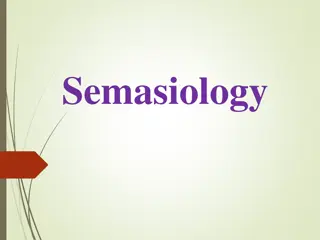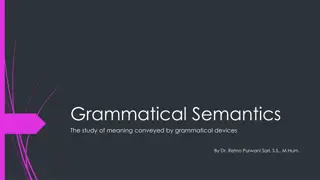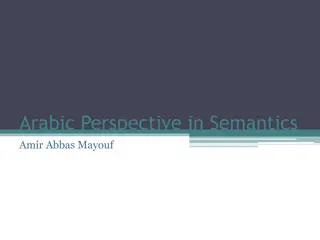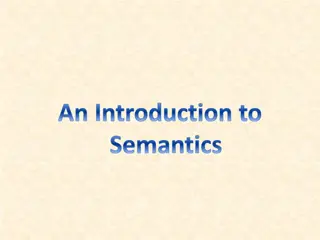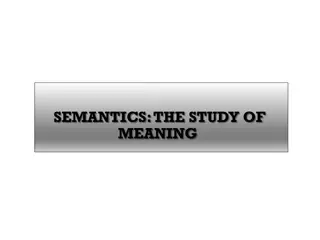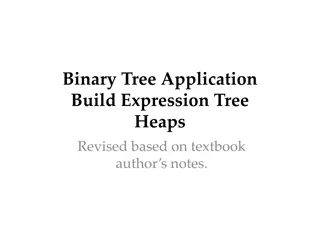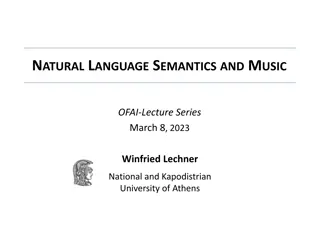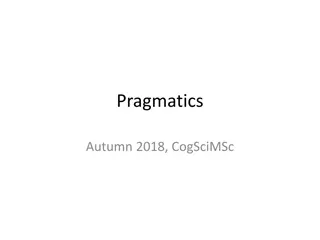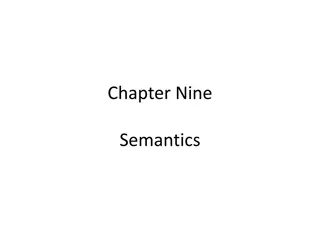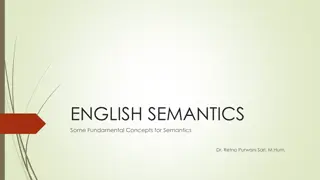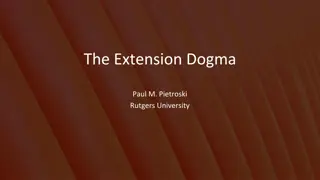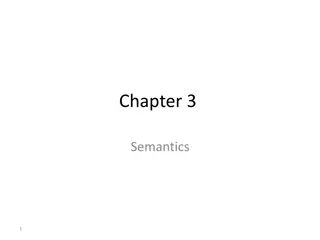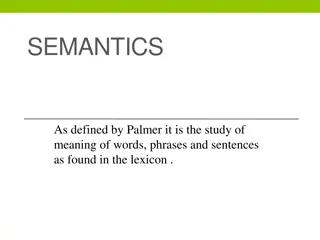Understanding Semantics: Exploring Linguistic Meaning and Expression
Exploring the realm of semantics, this content delves into how language is used to refer, denote, and express concepts in the world. It discusses the importance of linguistic meaning, different approaches to studying it, and the distinction between denotational and cognitive semantics. By examining how speakers use language to talk about the world, the content demonstrates the significance of understanding the relationship between signs and their meanings. It also touches on the concept of referring expressions and the complexities of deciphering meanings based on context and mental representations.
Download Presentation

Please find below an Image/Link to download the presentation.
The content on the website is provided AS IS for your information and personal use only. It may not be sold, licensed, or shared on other websites without obtaining consent from the author. Download presentation by click this link. If you encounter any issues during the download, it is possible that the publisher has removed the file from their server.
E N D
Presentation Transcript
Semantics Semantics Referring, denoting and expressing presented by : Nabaa Jassim
content SEMANTIC DEFINITION WHY WE USE LANGUAGE WAYS OF STUDYING LINGUISTIC MEANING DENOTATIONAL SEMANTICS VS. COGNITIVE SEMANTICS WHY WE ADOPT DENOTATIONAL APPROACH
2.1 2.1 Talking about the world Talking about the world speakers use language to talk about the world. Referring to a particular individual.Another important way is to describe situations in the world, i.e., to claim that a certain state of affairs exists. Ways of studying linguistic meaning : 1. One of these looks primarily at how a speaker s words are related to the thoughts or concepts he is trying to express. 2. The other approach looks primarily at how a speaker s words are related to the situation in the world that he is trying to describe. a. When Jones said that he was meeting a close friend for dinner,he meant his lawyer (specific reference ) b. Salamat means thank you inTagalog (meaning found in dictionary ) c. . Usufruct means the right of one individual to use and enjoy the property of another. ( sense found in dictionary ) One crucial difference between sense and reference is that reference depends on the specific context in which a word or phrase is used,whereas sense does not depend on context in this way.
. ambiguity, ways in which a word, phrase or sentence can have more than one sense. Expressive meaning (e.g. the meanings of words like ouch and oops) reflects the speaker s feelings or attitudes at the time of speaking 2.2 Denotational semantics vs. cognitive semantics Semiotics is the study of the relationship between signs and their meanings . the speaker s linguistic description rarely if ever includes everything that the speaker knows or believes about the situation The semiotic Triangle Mind The semiotic triangle Language World Thus there is no one-to-one correspondence between the speaker s mental representation and either the actual situation in the world or the linguistic expressions used to describe that situation.
cognitive semantics, focuses on the link between linguistic expressions and mental representations. Denotational focuses on the link between linguistic expressions and the world. Why we adopt denotational approach? 1. it is very hard to find direct evidence about what is really going on in a speaker s mind. . 2. this approach has proven to be quite successful at accounting for compositionality (how meanings of complex expressions,e.g.sentences,are related to the meanings of their parts). It turns out that native speakers are fairly good at judging whether a given sentence would be true in a particular situation;such judgments provide an important source of evidence for all semantic analysis. 2.3 Types of referring expressions Reference point to something in the world; that is, to direct the hearer s attention to something, or to enable the hearer to identify something.we might read that amyotrophic lateral sclerosis (ALS) is often referred to as Lou Gehrig s Disease,in honor of the famousAmerican baseball player who died of this disease. A referring expression is an expression (normally some kind of noun phrase) which a speaker uses to refer to something.The identity of the referent is determined in different ways for different kinds of referring expressions. Substances such as gold , salt name of people such as Abraham Lincoln . Name of species such as Camel , Octopus
. deictic elements (sometimes called indexicals) are words which refer to something in the speech situation itself. An anaphoric element is one whose reference depends on the reference of another NP within the same discourse. (This other NP is called the antecedent.) The pronoun he in sentence (4) is used anaphorically, taking George as its antecedent. Susan refuses to marry George because he smokes. quantifier phrases are not referring expressions. (The symbol # in (5b) indicates that the sentence is grammatical but unacceptable on semantic or pragmatic grounds.) b.[EveryAmerican male]i loves football;#he watched three games last weekend. reflexive pronouns are normally interpreted as having the same reference as their antecedent; but this principle does not hold when the antecedent is a quantified noun phrase a.John trusts himself is equivalent to:John trusts John b.Everyone trusts himself is not equivalent to:Everyone trusts everyone. 2.4 Sense vs.denotation The German logician Gottlob Frege (1848 1925) was one of the first people to demonstrate the importance of making this distinction..He used the German term Sinn (English sense) for those aspects of meaning which do not depend on the context of use,the kind of meaning we might look up in a dictionary.
The denotation of a referring expression,such as a proper name or definite NP,will normally be its referent. . The denotation of a content word (e.g. an adjective, verb, or common noun) is the set of all the things in the current universe of discourse which the word could be used to describe. The denotation of a content word depends on the situation or universe of discourse in which it is used. In our world Two expressions that have different senses may still have the same denotation in a particular situation. If two expressions can have different denotations in any context,they do not have the same sense. Such examples demonstrate that two expressions which have different senses may have the same denotation in certain situations. However, two expressions that have the same sense (i.e., synonymous expressions) must always have the same denotation in any possible situation. Frege s distinction allows us to see that non-referring expressions like those in (12) may not have a referent, but they do have a sense,and that sense is derived in a predictable way by the normal rules of the language.


